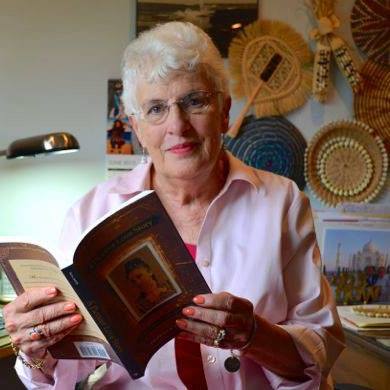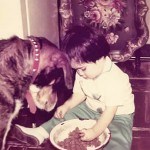 As I dust the pictures on our bedroom wall, memories of long ago swirl. Mary, now forty-six, is one-year-old sitting in front of Duke on the kitchen floor handing him his food from his dog bowl.
As I dust the pictures on our bedroom wall, memories of long ago swirl. Mary, now forty-six, is one-year-old sitting in front of Duke on the kitchen floor handing him his food from his dog bowl.
My mind slips back to 1962. Rod and I have two sons but yearn for a daughter. I had wanted to become pregnant for eight years, but no luck.
One evening the TV News highlights the Chinese refugees streaming into Hong Kong. Rod and I suddenly have the same thought, “Why not adopt one of those little girls who have no family; an international adoption? Maybe we can have a daughter that way.”
I investigate and find that adopting a child from another country means working through a state agency. I telephone the state agencies and Eleanor from the State of Illinois Department of Children and Family Services is assigned to us. She will determine if our family is special enough to receive a little girl. She can then search for a little girl who will fulfill our dreams.
International adoptions suddenly look more difficult than we had assumed. We have no money to travel to China to work out an adoption which would be required.
One day Eleanor asked, “Do you care what kind of baby we find, must it be an international adoption?”
“Anything as long as she is a girl,” I reply.
Several weeks later she calls, “Can you come to my office? I have a picture of a little girl for you to see.”
Looking at the picture captivates our hearts. Bright brown eyes peaking out from a frame of thick dark hair look irresistible.
Eleanor explains, “Native American tribes have begun to change their restrictions concerning adoption. Previously these communities kept their children with the tribe. However, the Nevada State Department of Health and Welfare, the Welfare Division has suggested this little girl can be available for you. Born in Reno, Nevada on September 10, 1963, this girl is known as Baby Girl Downs.”
Eleanor said, “The birth parents signed a release when the baby was born because they did not feel they could afford to keep another child. The birth mother, twenty-three years of age is half Paiute on her father’s side and a quarter each Shoshone and Caucasian on her mother’s side. The baby’s birth father is three-quarter Paiute and one quarter Caucasian.”
This heritage mix seemed irrelevant, though interesting. The baby is a girl; that is the exciting information.
Eleanor goes on to say, “Baby Girl Downs has lived with foster parents since she was six days old. The foster parents are an older couple in their fifties and another baby girl lives in their home also.”
We express bubbling excitement, “Yes, please do whatever is necessary to make this real for us.”
Both hope and frustration consume me as the weeks go by. Home visits with Eleanor include conversations with Rod and I together and separately.
She talks with our boys, Ben, ten years old and Tim, eight. They both tell Eleanor, “Having a baby sister would be fun.”
June 24, 1964, the long wait is over. At last, the baby girl named for both of our mothers, is scheduled to arrive; Mary for my Mother and Helyn for Rod’s Mother. We can’t wait to greet Mary Helyn Wilson. Excitement rises to a fevered pitch as we drive to the airport.
We tell the story that all four in the baby’s new family had an anesthetic of root beer floats. This helps pass the time at Chicago’s O’Hare Airport while waiting for the United flight from Reno. The root beer floats are the best treat of the day for the boys.
At last, the Nevada social worker departs the plane, a modern baby-carrying stork, with an eighteen-pound, nine-month old baby girl. Our anticipation accelerates as we spot this precious one with a mop of dark hair; dressed to meet her new family in a pink playsuit. Her two bottom teeth peak out as she smiles. We ache to hold her.
The two social workers, Nevada and Illinois, communicate “new parent” advice in the lounge area of the airport. Then share parting remarks, “We won’t go home with you. You and your family need a restful time to welcome this baby girl into your home.”
I carry our baby daughter gently to the parking garage. We cautiously drive the six and a half miles from the airport to our home on NE Circle in Norwood Park.
The community buzzes when word of the baby girl’s arrival spreads. During the next forty-eight hours ten to twelve neighbors drop by to meet Mary. But the real kick happens when twenty-five teen-agers come by our house. The teens, from the Norwood Park Presbyterian youth group, can‘t wait to meet the new wonder in our midst. For ten years I have worked with the Church Youth Group. These kids are nearly as excited as we are. A baby shower a couple of weeks before Mary with the teens introduced the boys in the group to a whole new phenomenon.
An exciting, though not particularly restful time, greets this new member of our family. Finally, when there is a lull in the activity, father and baby fall asleep on the quilt in the middle of the living room floor.
On her second day in our home, Mary surveys the neighborhood from Priscilla’s bike, strapped into a new baby seat. What a fun four days for all.
Mary is an angel as we all get to know her, including our dog, Duke. She squeals with glee when he comes into view. Such a good baby, never registering fear at anything. She expresses interest in all that is happening, including spending an hour at a boy-scout picnic on Saturday.
The only problem is getting her to sleep. Wary of conking off…she appears to be afraid we will all disappear. Once she is asleep, she is content.
Long, dark eyelashes highlight the face of this beautiful child. Men swoon. For a child so young, her beautiful, dark mop of hair creates a large frame for her face. The hair practically begs to be cut, which we intend to see to that first week.
Mary loves being in the playpen, but shows distrust at being left on the floor alone. Who are we to argue? She had shared her first nine months
with another baby girl in their foster home. Alone is a new experience.
We purchased the playpen to be used in the yard, a typical fence around a platform up off the ground. Yet, when we bring it into the living room, she loves it. When eight-year old Tim climbs into the playpen with her, she is delighted. Her happiness quotient rises in proportion to the number of people around so we call her “Sociability Sue.”
Her two brothers express their love by jabbering in baby talk and playing with her fingers and toes. She gives the impression that they are great as she coos and giggles.
They want to hold her, feed her and even change her diaper as long as it is only wet. They beg to take this new sister to school for “show and tell.” Tim wheels her as far as the corner in her new red stroller. The neighborhood kids gather round and admire this new neighbor.
Tim stands back against the fence eyeing all the admiration, and later confesses, “I wasn’t too sure before she came whether I’d like her or not, but I sure do now that she is here.”
The next year and a half flies by with social worker visits and finally a court visit. The real red-letter day is April 7, 1966 when the Certificate of Adoption rests in our hands signed and finalized by a stern looking judge. We rejoice to have lived through all of the government bureaucracy. Now the daughter we had longed for is truly ours.
Each day is filled with specialness. Two lively and energetic boys engaged in school, friends and play. Now this baby girl, as any new baby does, adds to all the hustle and bustle in our young family. Rod, the boys and I all picked up part of the care tasks that baby-hood calls for.
Watching Mary discover Duke’s dish and feeding him bits of his dog food is fun.
I was and always will be alive with the activities of motherhood. This other female dynamic added a softness and gentleness in our household that is often present in the feminine.
What made this adoption work? Was it her good health, the immediate acceptance of all our family and friends, or were we just lucky? Our daughter, and sister, was whole-heartedly welcomed as a Wilson.
It has been a forty plus year journey of watching a little girl grow into womanhood. A desire to have a daughter became a dream come true.
The pictures of Mary, Duke and the food dish still hang on our bedroom wall 40-some years later.

